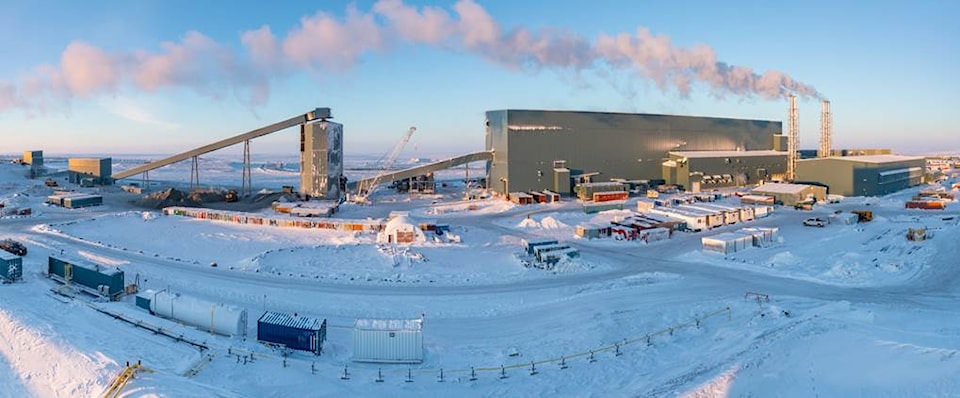The Nunavut Water Board is expected to hand down its decision on a proposed amendment to Agnico Eagle's water licence for its Meliadine gold mine in the coming few weeks after the final round of public consultations wrapped up in Rankin Inlet last month.
Agnico Eagle is asking the Nunavut Water Board to amend the company's water permit for
Meliadine Lake to increase the maximum total dissolved mineral concentration solids (TDS) limits to 4,500 mg/L, up from the current limit of 1,400 mg/L.
The company had originally requested for the maximum grab limit to be 5,000 mg/L but ended up lowering the number based on feedback from Environment and Climate Change Canada, according to an email from Carl Charest, communication general supervisor for Agnico Eagle.
As part of the amendment the company is also requesting to increase the average levels to a maximum of 3,500 mg/L, up from the current limit of a maximum of 1,400 mg/L.
According to Sergey Kuflevskiy, technical advisor in charge of the Meliadine file for the Nunavut Water Board, more than 100 people attended the meetings in person over the course of two days, with another 50 tuning in online via Zoom.
“The numbers were actually record breaking compared to other public hearings,” Kuflevskiy
told Kivalliq News.
Most of the concerns voiced during the two days of meetings were related to the impact that
the changes would have on the water quality at Meliadine Lake. The TDS going into Meliadine Lake are mostly composed of natural occurring salts such as chloride, which accounts for approximately 50 per cent of its contents.
According to Kuflevskiy one member of the public who attended the meeting asked if it is
visibly noticeable if you have 3,500 mg of dissolved solids in a water sample.
In an interview with Kivalliq News, Kuflevskiy explained that the tap water you drink has
roughly 400 to 500 mg of TDS.
“And this is water that is purified and that is clean,” he said, adding that ocean water can have as much as 35,000 mg/litre of TDS. “When we compare ocean water and lake water, you're not going to be able to see the difference in TDS.”
According to Kuflevski, another member of the public at the meeting asked if heavy metals are included in these calculations.
“The answer is no,” he told Kivalliq News. “The heavy metals have their threshold and those are not being changed with this application.”
Emergency amendment in 2020
The water licence Agnico Eagle currently holds was approved by the Nunavut Impact Review Board in 2016 and allows the company to discharge rainwater and accumulated snow from the mine site into Meliadine Lake as long as it meets the NWB's guidelines.
Last year Agnico Eagle received approval from the NWB for an emergency amendment because of unexpectedly high precipitation levels.
The temporary change to Agnico's water licence allowed the company to increase its discharge of TDS to 3,500 mg/L of from Containment Pond 1 to Meliadine Lake through the Meliadine Lake outfall diffuser between April 29 and October 31.
That permit was approved as a temporary measure because Agnico did not have enough time to submit a full application in time for the spring melt.
Following the approval of last Spring's temporary amendment, Stephanie Autut, executive
director of the NWB wrote an open letter in which she explained why the approval was
necessary.
One of the points she made was that the additional discharge was urgently required to lower water levels and avoid permanent damage to the pond and associated water management
infrastructure at the site.
“If the excess water in CP1 could not be discharged to Meliadine Lake during the spring freshet in 2020, damage to the pond and infrastructure could result, which increased the potential for uncontrolled releases or other negative impacts on Meliadine Lake,” she wrote.
As part of the emergency application the water board told the mine they needed to submit a
permanent application to the board, which is why it is currently submitting its current
application. By law, the NWB has nine months to process the application, whether it's approved or not.
“Some people ask why it's such a rush and why can't it take two years. The legislation says
that's the way it must be,” said Kuflevskiy.
Two different amendments
A confusing aspect of the current application is that Agnico is currently seeking two separate amendments to its water licence, said Kuflevskiy.
The one currently being discussed is being heard by the NWB as it pertains to inland fresh
water.
The other, which is seeking permission to build two pipelines to carry water from the mine to Melvin Bay, falls under the jurisdiction of the Nunavut Impact Review Board, as the NWB doesn't have jurisdiction over the ocean.
That application is still in progress and public consultations still need to be held before it can be reviewed by NIRB.
“It's a very complex project and it's even more complex because there's two applications and people are always confusing the two,” explained Kuflevskiy. “We receive feedback about the pipeline but it's not related. I understand that it's really confusing to members of the public.”
“The NIRB is going to have its public hearing and its community round table where people will be able to ask questions about the pipeline but it's a separate process.”
Once the NWB hands down its ruling on the Meliadine Lake amendment, it will be submitted to the federal Department of Crown-Indigenous and Northern Affairs.
The federal government then has 45 days to make its final decision on whether or not to
approve the amendment.
